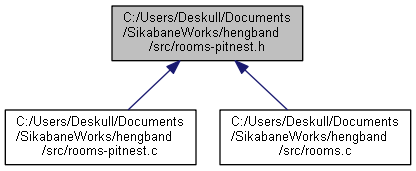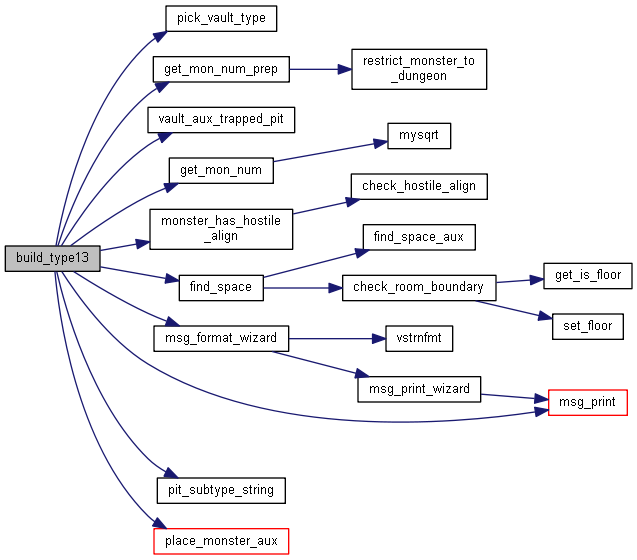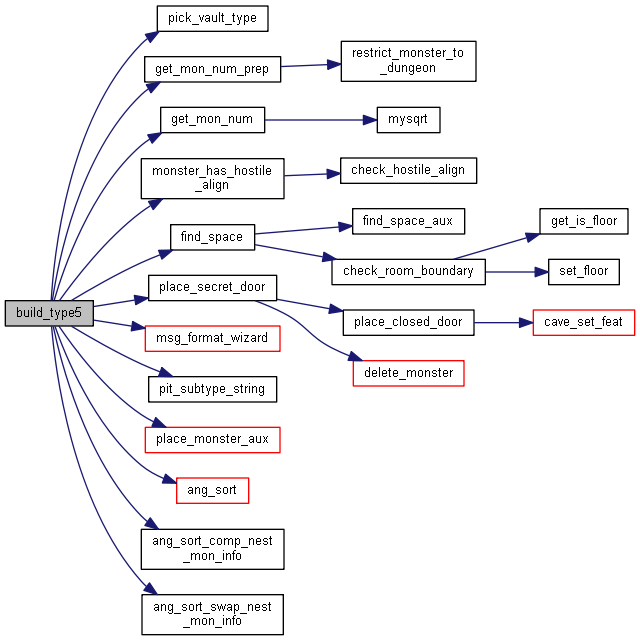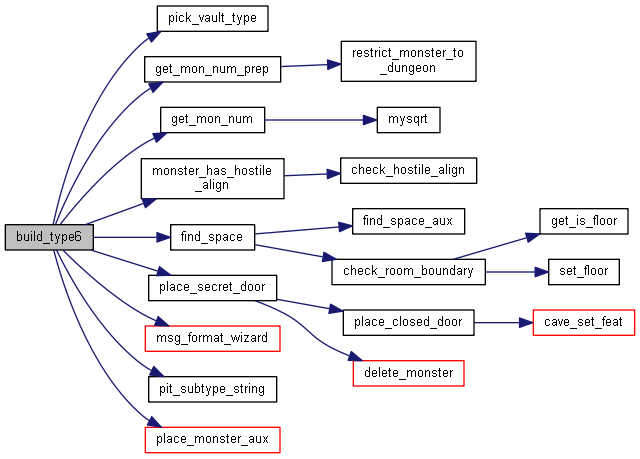 |
Hengband
2.2.1
|
 |
Hengband
2.2.1
|

データ構造 | |
| struct | nest_mon_info_type |
| デバッグ時にnestのモンスター情報を確認するための構造体 / A struct for nest monster information with cheat_hear [詳解] | |
関数 | |
| bool | build_type5 (floor_type *floor_ptr) |
| タイプ5の部屋…nestを生成する / Type 5 – Monster nests [詳解] | |
| bool | build_type6 (floor_type *floor_ptr) |
| タイプ6の部屋…pitを生成する / Type 6 – Monster pits [詳解] | |
| bool | build_type13 (floor_type *floor_ptr) |
| タイプ13の部屋…トラップpitの生成 / Type 13 – Trapped monster pits [詳解] | |
| bool build_type13 | ( | floor_type * | floor_ptr | ) |
タイプ13の部屋…トラップpitの生成 / Type 13 – Trapped monster pits
A trapped monster pit is a "big" room with a straight corridor in
which wall opening traps are placed, and with two "inner" rooms
containing a "collection" of monsters of a given type organized in
the room.
The trapped monster pit appears as shown below, where the actual
monsters in each location depend on the type of the pit
XXXXXXXXXXXXXXXXXXXXXXXXX
X X
XXXXXXXXXXXXXXXXXXXXXXX X
XXXXX001123454321100XXX X
XXX0012234567654322100X X
XXXXXXXXXXXXXXXXXXXXXXX X
X ^ X
X XXXXXXXXXXXXXXXXXXXXXXX
X X0012234567654322100XXX
X XXX001123454321100XXXXX
X XXXXXXXXXXXXXXXXXXXXXXX
X X
XXXXXXXXXXXXXXXXXXXXXXXXX
Note that the monsters in the pit are now chosen by using "get_mon_num()"
to request 16 "appropriate" monsters, sorting them by level, and using
the "even" entries in this sorted list for the contents of the pit.
Hack – all of the "dragons" in a "dragon" pit must be the same "color",
which is handled by requiring a specific "breath" attack for all of the
dragons. This may include "multi-hued" breath. Note that "wyrms" may
be present in many of the dragon pits, if they have the proper breath.
Note the use of the "get_mon_num_prep()" function, and the special
"get_mon_num_hook()" restriction function, to prepare the "monster\n
allocation table" in such a way as to optimize the selection of
"appropriate" non-unique monsters for the pit.
Note that the "get_mon_num()" function may (rarely) fail, in which case
the pit will be empty.
Note that "monster pits" will never contain "unique" monsters.

| bool build_type5 | ( | floor_type * | floor_ptr | ) |
タイプ5の部屋…nestを生成する / Type 5 – Monster nests
A monster nest is a "big" room, with an "inner" room, containing
a "collection" of monsters of a given type strewn about the room.
The monsters are chosen from a set of 64 randomly selected monster
races, to allow the nest creation to fail instead of having "holes".
Note the use of the "get_mon_num_prep()" function, and the special
"get_mon_num_hook()" restriction function, to prepare the "monster\n
allocation table" in such a way as to optimize the selection of
"appropriate" non-unique monsters for the nest.
Note that the "get_mon_num()" function may (rarely) fail, in which
case the nest will be empty.
Note that "monster nests" will never contain "unique" monsters.

| bool build_type6 | ( | floor_type * | floor_ptr | ) |
タイプ6の部屋…pitを生成する / Type 6 – Monster pits
A monster pit is a "big" room, with an "inner" room, containing
a "collection" of monsters of a given type organized in the room.
The inside room in a monster pit appears as shown below, where the
actual monsters in each location depend on the type of the pit
XXXXXXXXXXXXXXXXXXXXX
X0000000000000000000X
X0112233455543322110X
X0112233467643322110X
X0112233455543322110X
X0000000000000000000X
XXXXXXXXXXXXXXXXXXXXX
Note that the monsters in the pit are now chosen by using "get_mon_num()"
to request 16 "appropriate" monsters, sorting them by level, and using
the "even" entries in this sorted list for the contents of the pit.
Hack – all of the "dragons" in a "dragon" pit must be the same "color",
which is handled by requiring a specific "breath" attack for all of the
dragons. This may include "multi-hued" breath. Note that "wyrms" may
be present in many of the dragon pits, if they have the proper breath.
Note the use of the "get_mon_num_prep()" function, and the special
"get_mon_num_hook()" restriction function, to prepare the "monster\n
allocation table" in such a way as to optimize the selection of
"appropriate" non-unique monsters for the pit.
Note that the "get_mon_num()" function may (rarely) fail, in which case
the pit will be empty.
Note that "monster pits" will never contain "unique" monsters.

 1.8.15
1.8.15